The HTC One (M8) Review
by Anand Lal Shimpi & Joshua Ho on March 26, 2014 7:00 PM EST- Posted in
- Smartphones
- HTC
- Mobile
- HTC One
Battery Life
The new One features an integrated 3.8V 2600mAh battery (9.88 Wh), a 13% increase in capacity compared to the previous model. The battery comparison isn’t that simple however. The M8 has a larger display (5” vs 4.7”) but it also has a higher performing and more power efficient SoC (Snapdragon 801 vs. 600). To find out how the new One stacks up against its predecessor, we turn to a mix of old and new battery life tests to help better characterize the device.
We’ll start with our standard browser based battery life tests. Keep in mind here these tests are as much about replicating a particular CPU profile as they are about loading specific web pages in order.
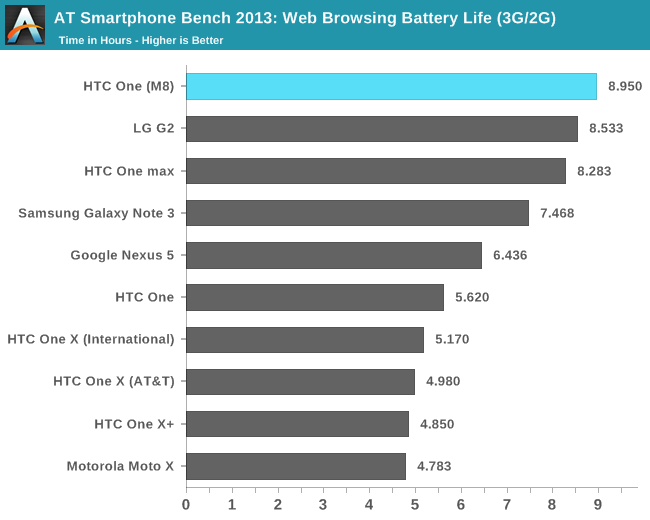
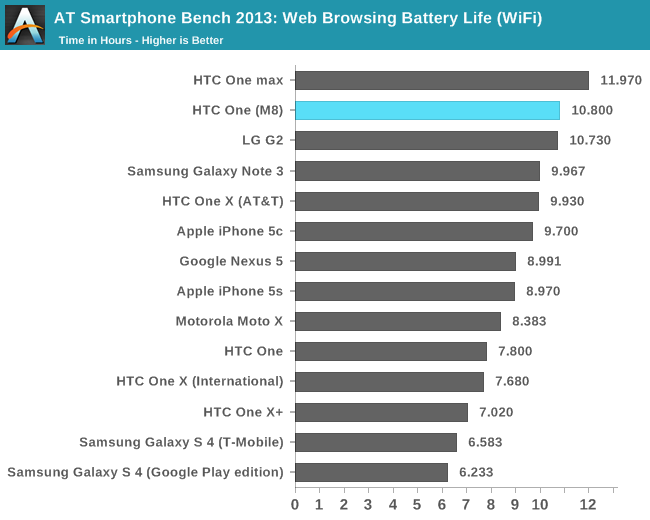
We saw a substantial gain in battery life with Snapdragon 800, and 801 extends that even further. For the same, relatively light (yet constant) workload, the M8 improves battery life over the M7 by as much as 71%. On WiFi the advantage drops to only 38%, but we’re still talking about absolutely huge generational gains.
A constant workload is only one part of the story though. More often than not, when you’re faced with faster compute you end up doing more. To see what the other extreme of battery life looks like I turned to two canned tests: BaseMark OS II and GFXBench 3.0.
I ran both of these tests under the same controlled conditions we always use, with all displays calibrated to 200 nits. BaseMark OS II runs through a bunch of CPU and storage benchmarks (basically the same tests used for the BaseMark OS II system and memory tests), as fast as possible, until the battery dies.
I like this benchmark as it gives us an indication of worst case battery life if you’re absolutely hammering the CPU (and storage) relentlessly.
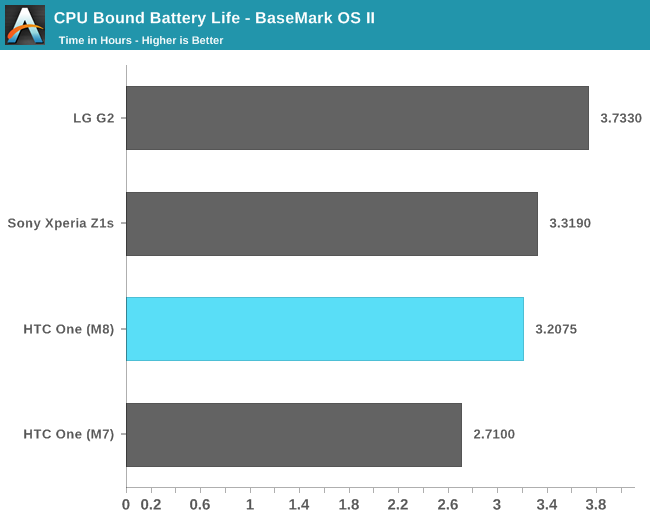
Despite the faster CPU cores, the M8’s battery life actually goes up compared to M7. Here we’re really seeing the benefits of 801’s updated 28nm HPm process compared to the Snapdragon 600’s 28nm LP process.
GFXBench provides a similar test, with effectively uncapped performance (on today’s devices at least since we’re not hitting v-sync limits), but stressing the GPU instead of the CPU. Here we’re running the T-Rex HD benchmark, onscreen, until the battery dies.

This is the first and only test we’ve got here that shows a regression in battery life compared to M7. The M8 loses about 6% of runtime compared to the M7, despite having a larger battery. Now look at what happens if we look at performance at the end of the run:
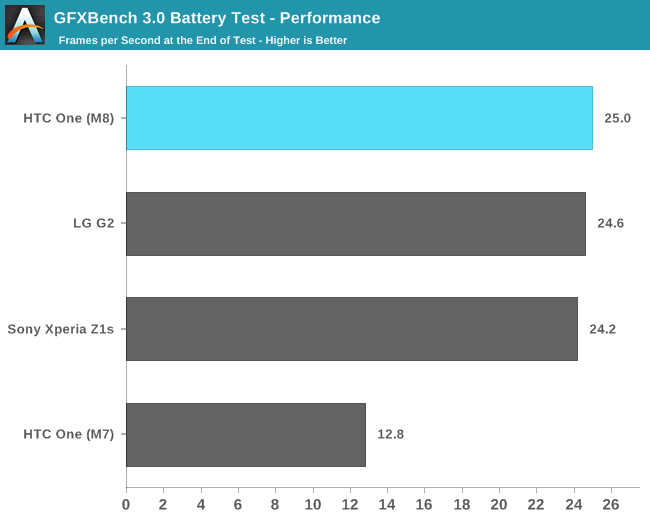
Now the M8’s battery life regression doesn’t look so bad. You give up 6% of runtime but you get almost twice the performance compared to M7. Snapdragon 801 is just a huge upgrade compared to 600.
Charge Time
The M8 features a Qualcomm Quick Charge 2.0 enabled PMIC, which enables faster battery charge times through higher voltage charging. Unfortunately the in-box wall adapter is only Quick Charge 1.5 compliant so you'll only pull 7.5W from the wall. HTC expects to offer a Quick Charge 2.0 compliant power adapter later this year.
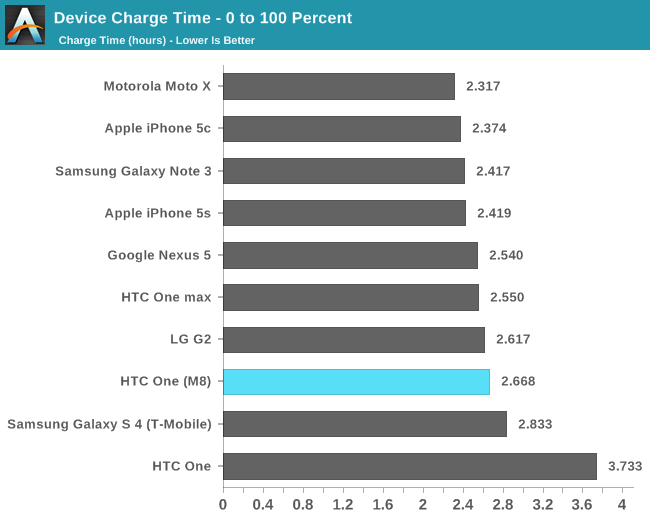
The M8's charge time is a bit slow compared to what we've seen from other devices with larger batteries.










222 Comments
View All Comments
nerdstalker - Thursday, March 27, 2014 - link
It could have been a good move by Brian if he updated his info on Twitter, LinkedIn etc, to reflect any changes (if there is) to his affiliation with AnandTech. A short "thank you, good luck and btw we left in good terms" confirmation tweet from Anand (similar to his post above) would clear most questions. Just my 2 cents. :)Anand Lal Shimpi - Thursday, March 27, 2014 - link
All in due time, privacy is an important thing :)Anand Lal Shimpi - Thursday, March 27, 2014 - link
Audio quality is coming, just didn't have the time to get the review unit out to Chris. Similarly time constrained on network connectivity, I plan on grabbing the data when I'm back in NC this weekend.yelped - Thursday, March 27, 2014 - link
Ok. Thanks for the clarification.George Carlin Jr. - Wednesday, March 26, 2014 - link
Only a 4MP camera? WTF? Why can't just ONE single phone maker make a phone with the best of everything? They always skimp or screw up at least one thing. Why is that?madwolfa - Wednesday, March 26, 2014 - link
Never needed more than 4 megapixels for sharing pics on Facebook (which is what 99% people are doing with their phones). For anything else, I have my DSLR.Blairh - Thursday, March 27, 2014 - link
Total BS.Egg - Wednesday, March 26, 2014 - link
Read the 2013 HTC One review to understand this design choice...AnnonymousCoward - Wednesday, March 26, 2014 - link
4MP made great sense a couple years ago, but now days more people are getting higher res screens. 30"ers are 4.1MP, and some new tablets and laptops are also in the territory. I think ~2x the screen res is a good amount for the sensor, so that pixel averaging works well for the final product. I think they should have gone with 6-8MP, same pixel size, and with optical stabilization.asaini007 - Thursday, March 27, 2014 - link
I feel like they could've if they would've. Perhaps such components don't exist, are far too expensive, or would not meet design constraints. They did they best with what they could I assume.And I actually think the secondary camera is kinda neat for fun effects, which will appeal to the mass market which HTC desperately needs.